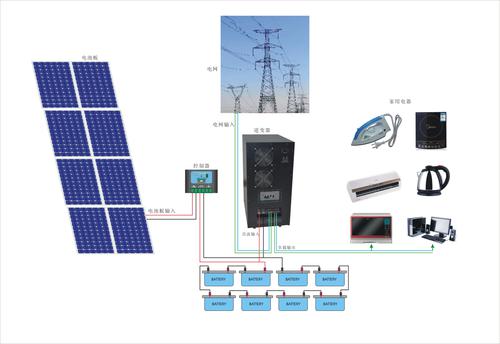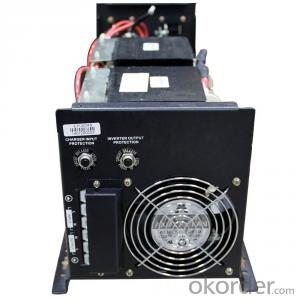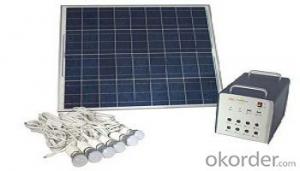Carolina Solar Energy Systems Complete 24V 1000W Stand Alone Solar Systems
- Loading Port:
- Guangzhou
- Payment Terms:
- TT OR LC
- Min Order Qty:
- -
- Supply Capability:
- 1000sets set/month
OKorder Service Pledge
OKorder Financial Service
You Might Also Like
Features
Solar cell modules
It converts solar energy into electrical energy and the frames support solar panels.
Charge controller
It supplies direct current regulated from solar modules to the battery or inverter.
Stand-Alone Inverter
It supplies alternative current to loads after rectifying the direct current.
Battery
It supplies the electric power to loads through inverter in case the electric power generated from solar modules is in short supply or at night.
Complete 24V/1000W stand alone solar systems
5×200w poly solar panels//1×24V/50A solar charge controller//1×48V/3000W pure sine wave
inverter//4×12V/200Ah lead acid batteries//ground mounting brackets//50m PV cables for solar
panels connection//dual connectors for solar panels connection//connection cables for batteries.
average produce 6kwh power each day!!!
| 12V/200W Poly-crystalline Solar Panels | ||||||||
| Model: 200P Maximum power:200W Maximum power voltage:35V Maximum power current:5.71A Open circuit voltage:42.48V Short circuit current:6.29A Dimension:1350mm×1000mm×45mm Weight: 17.5kg Solar cells:48pieces(6×8)poly solar cells156mm×156mm;Grade A; CE certification Maximum systems voltage: 1000V |  | |||||||
| | ||||||||
| | ||||||||
| | ||||||||
| | ||||||||
Wiring of solar panels: 1 panels in series, 5 strings in parallel | ||||||||
| 24V/50A solar charge controller | ||||||||
| Model:KF2450 Rated voltage: 24V Rated current: 50A Over-voltage protection 34V Over-discharge recover voltage: 25V working temperature: -20℃~45℃ Dimension: 184mm×110mm×57mm Weight: 0.66kg Features: battery switch |  | |||||||
| | ||||||||
| | ||||||||
| | ||||||||
| | ||||||||
| | ||||||||
| Wiring of solar charge controller: firstly connect solar charge controller with battery bank, then connect solar charge controller with solar panels array, at last connect solar charge controller with loads or pure sine wave inverter | ||||||||
| 48V/3000W Pure Sine Wave Inverter | ||||||||
| Model:XD-NB10224 Rated input voltage:DC24V Input voltage range:75V~125V OR 145V~275V Output voltage:AC210V~AC240V Rated output power:1000W Maximum output power:2000W Output wave form: pure sine wave Dimension:396mm×190mm×240mm Weight:14kg. Working temperature: 0℃~40℃. Battery low voltage shutdown: DC21V |  | |||||||
| | ||||||||
| | ||||||||
| | ||||||||
| | ||||||||
| 12V/200Ah deep cycle battery | ||||||||
| Deep cycle batteries in our stand alone solar systems have 2000 time charging-discharging cycle at 50% DOD. Gel batteries have better performance than lead acid batteries under cold temperature. besides, these battery are free-maintenance. |
| Package&shipment terms | |||||||||
| 1,We would pack all components into one plywood case and put much foam inside of plywood case, this packing way can make all components stand long distance transportation. 2,Because batteries are a kind of very heavy components and can't be allowed to transport by air, we have to choose sea transportation. though sea transportation would take more days to arrive, however you can save much postage. 3.We would ship the system to any bigger port near to customers, customers need to go to the port and pick up the system. |
- Q: How do solar energy systems integrate with other renewable energy sources?
- Solar energy systems can integrate with other renewable energy sources through a concept known as hybrid renewable energy systems. These systems combine the generation of solar power with other sources like wind, hydro, or biomass to create a more reliable and efficient energy solution. By diversifying the energy sources, a hybrid system can ensure continuous power supply even when there is insufficient sunlight. Additionally, the integration of multiple renewable sources allows for better utilization of resources and enhances the overall sustainability of the energy system.
- Q: Can solar energy systems be used in areas with limited access to social services?
- Yes, solar energy systems can be used in areas with limited access to social services. Solar energy systems are independent of traditional power grids and can operate off-grid, making them suitable for remote and underserved areas. These systems can provide reliable and clean energy, improving the quality of life by powering essential services such as lighting, heating, and water pumping, even in areas with limited access to social services. Additionally, solar energy systems can contribute to economic development by reducing dependence on expensive and unreliable energy sources, promoting self-sufficiency, and enabling the growth of local businesses.
- Q: Can solar energy systems be used in areas with limited access to solar panel manufacturers?
- Yes, solar energy systems can still be used in areas with limited access to solar panel manufacturers. In such cases, the focus would be on importing solar panels from manufacturers in other regions or countries. Additionally, efforts can be made to promote local manufacturing or assembly of solar panels to overcome the limitations and ensure the availability of solar energy systems in those areas.
- Q: Can solar energy systems be installed on multi-story buildings?
- Yes, solar energy systems can be installed on multi-story buildings. The installation process may require careful planning and considerations due to the building's height, available space, and structural integrity. However, with appropriate design and engineering, solar panels can be mounted on rooftops, facades, or even as elevated structures to harness solar energy efficiently on multi-story buildings.
- Q: Can a solar energy system be installed on a community center or clubhouse?
- Certainly, it is entirely possible to install a solar energy system on a community center or clubhouse. As a matter of fact, community centers and clubhouses are prime locations for solar installations due to their expansive roof spaces and considerable energy consumption. By placing solar panels on the roof of a community center or clubhouse, the facility can effectively generate clean and sustainable electricity to fuel its operations. The utilization of solar energy systems can contribute to the reduction of electricity bills, the mitigation of carbon emissions, and the advancement of sustainable development within the community. Moreover, by integrating solar panels with battery storage systems, any surplus energy generated during daylight hours can be stored and utilized during the night or during periods of high demand. All in all, the installation of a solar energy system on a community center or clubhouse serves as an excellent opportunity to exhibit environmental leadership and inspire others within the community to adopt renewable energy.
- Q: What is the impact of dust storms on solar panels?
- Dust storms can have a significant impact on solar panels. The accumulation of dust and debris on the surface of solar panels can block sunlight from reaching the photovoltaic cells, reducing their efficiency and overall electricity generation. Dust particles on the surface of the panels create a barrier that prevents sunlight from penetrating and being converted into electricity. This can result in a decrease in power output and a decrease in the overall performance of the solar panel system. Furthermore, dust storms can also cause physical damage to the panels. Strong winds during a dust storm can carry abrasive particles that can scratch or chip the surface of the panels, leading to long-term degradation and reduced efficiency. The accumulation of dust and debris can also increase the temperature of the panels, which can further decrease their efficiency. To mitigate the impact of dust storms on solar panels, regular cleaning and maintenance are essential. Cleaning the panels periodically to remove dust and debris can help maintain their efficiency and maximize electricity generation. Additionally, installing panel tilt systems or incorporating self-cleaning technologies can also minimize the impact of dust storms by effectively shedding off or preventing dust accumulation. Overall, dust storms can have a detrimental impact on solar panels, reducing their efficiency and potentially causing physical damage. However, with proper maintenance and cleaning practices, the negative effects of dust storms can be minimized, allowing solar panels to continue generating clean and sustainable energy.
- Q: What is the role of energy management systems in a solar energy system?
- Efficiently managing and optimizing solar energy generation, storage, and consumption, energy management systems are crucial in solar energy systems. These systems monitor and control various components, ensuring efficient utilization of energy produced by solar panels. A significant function of energy management systems is to regulate electricity flow between solar panels, energy storage systems, and connected loads. This involves constant monitoring of energy production and consumption levels, allowing adjustments for maximum efficiency. Real-time data and analytics on solar energy system performance are provided by energy management systems. This includes information on energy generation, consumption patterns, and overall system efficiency. By analyzing this data, users can identify areas for improvement and optimize system performance. Remote monitoring and control of solar energy systems are made possible by energy management systems. This allows users to conveniently monitor energy production, consumption, and storage levels from anywhere. It also enables users to remotely adjust settings or control loads during peak energy consumption periods. Furthermore, energy management systems prioritize the use of self-generated energy, maximizing the utilization of solar energy. Excess energy produced by solar panels can be directed towards charging the energy storage system instead of exporting it to the grid. This ensures efficient storage and utilization of solar energy, reducing reliance on the grid and maximizing the benefits. In conclusion, energy management systems are essential components in solar energy systems. They enhance overall performance and efficiency by efficiently managing electricity flow, providing real-time data, and enabling remote monitoring and control. By optimizing energy generation, storage, and consumption, these systems maximize the benefits of solar energy.
- Q: Can solar energy systems be used for emergency response operations?
- Yes, solar energy systems can be used for emergency response operations. Solar panels can generate electricity even during power outages, providing a reliable and sustainable source of energy to power critical equipment and facilities. Solar-powered generators can also be used to charge communication devices, run medical equipment, provide lighting, and support other emergency response activities in remote or disaster-stricken areas where access to traditional power sources may be limited or disrupted. Additionally, solar energy systems can help reduce dependence on fossil fuels and contribute to a more sustainable and resilient emergency response infrastructure.
- Q: How do solar energy systems impact the stability of the electricity grid?
- Solar energy systems can have both positive and negative impacts on the stability of the electricity grid. On one hand, they can enhance grid stability by diversifying the energy sources and reducing reliance on fossil fuels. Solar energy is a renewable resource that can be harnessed locally, which can help in reducing transmission losses and increasing grid resilience. On the other hand, the intermittent nature of solar power can pose challenges to grid stability. Fluctuations in solar generation due to weather conditions can require grid operators to manage the variability through energy storage or flexible backup power sources. Overall, the impact of solar energy systems on grid stability depends on effective integration and coordination with existing power infrastructure.
- Q: Can a solar energy system be used in conjunction with other renewable energy sources?
- Yes, a solar energy system can definitely be used in conjunction with other renewable energy sources. In fact, combining multiple renewable energy sources is often referred to as a hybrid renewable energy system, which can have several advantages. By combining solar energy with other sources such as wind, hydro, or geothermal energy, a hybrid system can provide a more reliable and consistent power supply. This is because different renewable energy sources have different patterns of energy generation, and combining them can help to compensate for any fluctuations or limitations in one particular source. For example, solar energy production is highest during the day, while wind energy can be more consistent throughout the day and night. By integrating these two sources, the system can provide a continuous power supply. Additionally, using multiple renewable energy sources can help to maximize the overall energy production and efficiency of the system. Each source has its own strengths and weaknesses, and combining them can help to increase the total energy output. This is especially valuable in situations where the energy demand is high or when one particular source may not be sufficient to meet the energy needs. Furthermore, a hybrid renewable energy system can also provide greater energy independence and resilience. By diversifying the energy sources, the system becomes less reliant on a single source and therefore less vulnerable to disruptions or failures. This is particularly important in remote or off-grid areas where access to a reliable power supply is crucial. In conclusion, a solar energy system can be effectively used in conjunction with other renewable energy sources to create a hybrid system. This approach offers several advantages, including increased reliability, improved efficiency, and enhanced energy independence. By combining multiple renewable energy sources, we can take advantage of their individual strengths and create a more sustainable and resilient energy system.
Send your message to us
Carolina Solar Energy Systems Complete 24V 1000W Stand Alone Solar Systems
- Loading Port:
- Guangzhou
- Payment Terms:
- TT OR LC
- Min Order Qty:
- -
- Supply Capability:
- 1000sets set/month
OKorder Service Pledge
OKorder Financial Service
Similar products
Hot products
Hot Searches
Related keywords



















